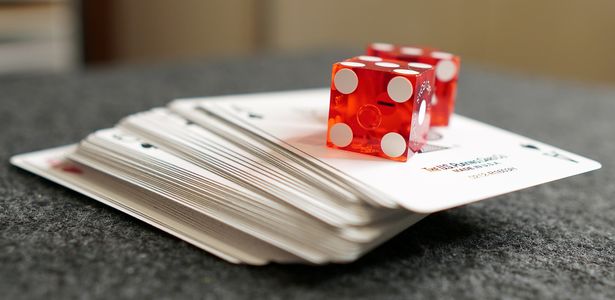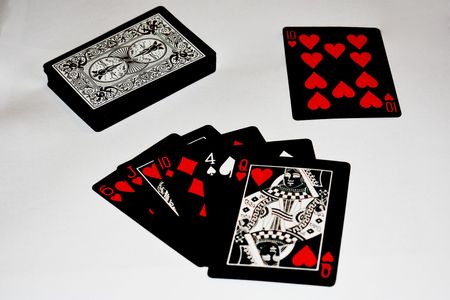Know The Probability Of Getting A Black Face Card In Poker

Table of content:
- What Is Probability?
- How To Compute Poker Probabilities?
- What Is The Probability Of Getting A Black Face Card In Poker?
- A Step Further
- Conclusion
- FAQ's
Poker involves a host of complex mathematical calculations based on probabilities. Good knowledge of numbers provides an essential basis for being a good poker player. For every decision that the player has to take, math and psychology will play a key role.
In this article, we will explain the importance of math in poker and give you a brief understanding of how one is to determine the odds of receiving a particular card or set of cards such as a black face card.
GetMega is an amazing platform that lets you play Hold'em Poker with friends & family with real money. Sounds fun, isn't it? Download the GetMega Hold 'em Poker now!
Understanding effective 7 Card Stud starting hands is pivotal for success in this classic poker variant. With each player receiving a combination of face-up and face-down cards, the choices made in the initial rounds significantly impact overall strategy. Identifying strong starting hands, such as pairs and high-ranking cards, provides a solid foundation for navigating the complexities of 7 Card Stud and pursuing favorable outcomes in subsequent betting rounds.
Black face card in a deck.
As we know there are total 26 black cards i.e. 13 of club and 13 of spades. There are 6 black face cards in deck of 26 black cards. Two kings of black, 2 queens of black and 2 jack of black.
What Is Probability?
Probability is the branch of mathematics that specifically deals with the prospect that one or the other outcome will occur. The number of possible outcomes in a card is much greater than say a coin flip as we are dealing with 52 different cards in the deck. The fifty-two cards will belong to one of the four suits and will be one amongst the thirteen rank – starting from deuce to ten, followed by jack, queen, king, and ace.

Say you were to pick up a card at random from this standard deck, then the probability of getting an ace as your first card is 4/52 or 1 in 13 i.e. in terms of percentage 7.7%. Similarly, if you wish to get a diamond card in your first pick, then the odds are 13/52 which is 1 in 4, a good 25% chance.
"What are the odds of a Royal Flush" is a common question in poker, especially considering the rarity and prestige of this hand. In standard poker variants like Texas Hold'em, the odds of being dealt a Royal Flush depend on the specific stage of the game. The overall probability of being dealt a Royal Flush in a standard Texas Hold'em game (from the starting hand through the community cards) is approximately 1 in 30,940 hands.
How To Compute Poker Probabilities?
A good place to begin would be to question the probability of getting a particular kind of card. For instance, you wish to understand the probability of getting a black card in a game.
The calculation would be the number of favourable outcomes/ the number of possible outcomes. Therefore, the probability or likelihood of getting a black card from a standard deck of cards is-
26 out of 52 = ½ or 50% (the 26 cards include both spade and clubs cards and 52 is the total number of cards in the deck).
"Dead Man's Hand poker" refers to the infamous poker hand consisting of two pairs: aces and eights. This combination gained historical significance due to Wild Bill Hickok, a legendary figure in the Old West, being allegedly shot while holding this hand during a poker game in 1876. The Dead Man's Hand has since become a symbol of ominous foreshadowing in poker lore, adding a layer of intrigue and historical connection to the game.
What Is The Probability Of Getting A Black Face Card In Poker?
As mentioned above, cards that are either spades or clubs are known as black cards. King, queen, and jack are known as face cards. Please remember, ace is not a face card.

Thus, the probability of getting a black face card is calculated as follows -
Number of face cards in clubs (king, queen, and jack or knaves) = 3
Number of face cards in spades (king, queen, and jack or knaves) = 3
Therefore, total number of black face card out of 52 cards = 3 + 3 = 6
Therefore, probability of getting ‘a black face card’ = number of favourable outcomes (i.e. the card that you wish to get)/ the number of possible outcomes =6/52 = 3/26 = 11.54% approx.
Face cards poker refer to the royal cards in a standard deck, which are the King, Queen, and Jack. These cards are distinguished by their illustrated faces rather than numerical values.
A Step Further
Now that you have understood the odds of getting a black face card, we would like to explain to you how the same mathematical concept can be extended to make a slightly more complex calculation. This is crucial while you are playing your hand in the next poker hand. A brief overview of how to calculate the probability of getting any of the poker hands (such as straight, royal flush, three of a kind) is explained below. The simplified steps are explained below –
- One must count the number of possible five card hands that can be dealt from a standard deck of 52 cards.
- After this one must count the number of ways that a particular type of poker hand can occur.
- The probability of being dealt any particular type of hand is equal to the number of ways it can occur divided by the total number of possible five card hands i.e.
Number of ways a particular hand can occur/Possible five-card hands.
- The possible five card hands that one can be dealt with, using the number of combinations of n objects taken r at a time, is calculated by using the combinations formula
nCr = n (n - 1) (n - 2) . . . (n - r + 1)/ r! = n! / r! (n - r)!
- For example, we have a standard deck of 52 cards (therefore, n = 52) and we wish to arrange them in unordered groups of 5, therefore r = 5. The number of combinations thus stands at 2598960, after applying the formula. Say we wish to count the number of ways in which a royal flush was to occur i.e. a sequence of 10, Jack, Queen, King, and Ace of the same suit. The number of ways that one can get a royal flush is 4 (as there are only 4 suits). Therefore, the probability of getting a royal flush is:4/ 2598960 =0.000 001 539.
In a standard deck of 52 playing cards, there are 12 face cards. Face cards in deck are the royal cards that have illustrated faces instead of numerical values. In each suit (hearts, diamonds, clubs, and spades), there are three face cards:
- King: There are four kings in a deck, one in each suit.
- Queen: There are four queens in a deck, one in each suit.
- Jack: There are four jacks in a deck, one in each suit.
Conclusion
There is no doubt that math plays an indispensable role in the game of poker. A good understanding of this will help the player adjust one’s tactics and strategies mid-game. The foundation of your countless winning streaks rests on a sound understanding of math. Invest some time and energy into improving your knowledge and understanding of math!
Explore the exciting world of online poker on our platform, where entertainment meets skill for a thrilling gaming experience.
FAQ's
What is the probability of getting a black face card?
- In a standard deck of playing cards, there are two black suits (spades and clubs) and each suit has three face cards (jack, queen, king). So, there are a total of 2 suits * 3 face cards = 6 black face cards. The probability is 6/52 or 3/26.
How many black cards are in 52?
- In a standard deck of 52 playing cards, there are 26 black cards. These include 13 spades and 13 clubs.
What is the probability of getting a black spade card?
- In a standard deck of 52 playing cards, there are 13 spades, and half of them are black. Therefore, the probability of drawing a black spade card is 1/4, or 0.25 (25%).
What are black face cards?
- Black face cards refer to the jack, queen, and king in the spades and clubs suits of a standard deck of playing cards. These cards are considered "black" because spades and clubs are the two black suits in the deck.
Is Joker a face card?
- No, the Joker is not considered a face card. Face cards are typically the jack, queen, and king in each suit of a standard deck of playing cards. The Joker is an extra card often included for specific games but is not a face card.
| Title | Slug |
|---|---|
| Top 8 Worst Starting Hands In Texas Hold 'Em Poker | the-worst-starting-hands-in-poker |
| All About The Starting Hands In Omaha Hi-Lo Poker | all-about-the-starting-hands-in-omaha-hi-lo-poker |
| The Odds Of A Full House | the-odds-of-a-full-house |

